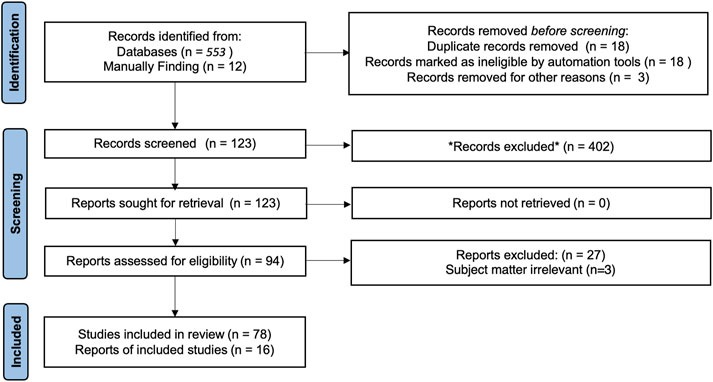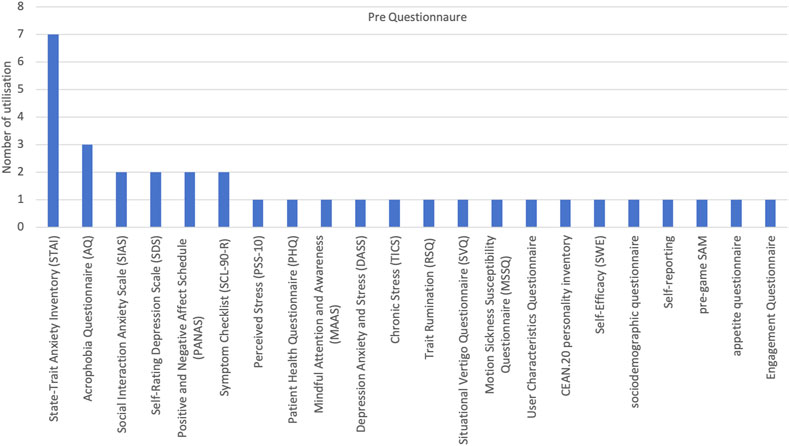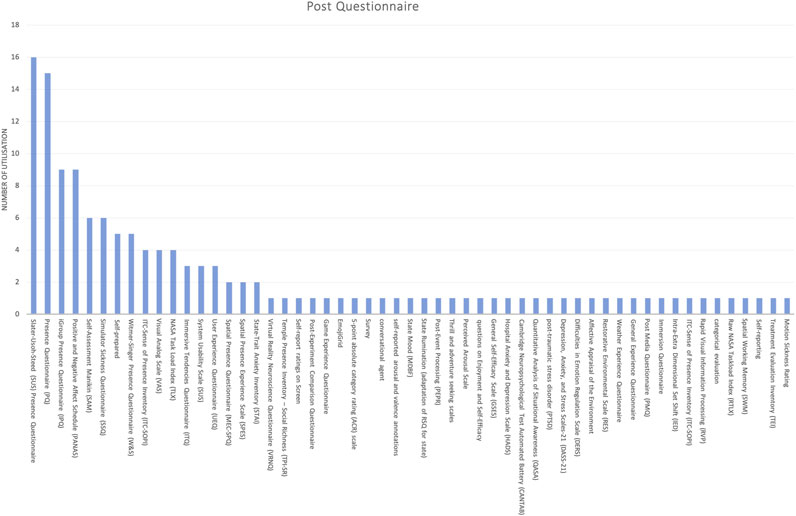- 1Plateforme d’Etude Sensorimotricité, INSERM US36 - CNRS UAR2009 - Université Paris Cité, Paris, France
- 2Machine Learning and I-health International Cooperation Base of Zhejiang Province, Hangzhou Dianzi University, Hangzhou, China
- 3Centre Borelli, CNRS, SSA, INSERM, Université Paris Cité, Université Paris Saclay, ENS Paris Saclay, Paris, France
- 4Centre Borelli, CNRS, SSA, INSERM, Université Paris Saclay, ENS Paris Saclay, Gif-sur-Yvette, Université Paris Cité, France
This review analyzes 94 articles in an attempt to define the concept of presence in virtual reality (VR). Two types of data were examined: physiological variables and questionnaires, which were used in 85% study of the selected articles. The physiological measurements focused mainly on head movements, as well as electromyographic and electrocardiographic activity. Over time, a gradual decrease in the use of questionnaires is noted, with a growing preference for physiological markers to define presence in VR. We analyzed papers with physiological measurement methods and noted additional usage of subjective questionnaires. This approach captures the complexity of the subject’s experience, which includes cognitive, emotional, and physical responses. Additionally, the increasing use of artificial intelligence, particularly deep learning, is a promising trend for defining this concept. Finally, this review raises two important issues that require further investigation. Firstly, the very nature of the neurophysiological variables recorded to detect presence: they are also recommended for quantifying stress and mental load, to name but a few behavioral characteristics. Consequently, none of them can be considered specific to presence in VR. Second, the number of people tested is often small, which often poses a problem, given the wide variety of methodologies used and the physiological and psychological reactions of the people tested in VR in the 94 studies we analyzed. Clearly, there is a need for larger-scale prospective studies to better define the concept of presence during a virtual reality immersion experience.
1 Introduction
What is presence? It is a complex concept that has been the subject of research since ancient Greece, when philosophical reflection addressed the problem of being, the metaphysics of presence. The authors of this review do not have the competence to deal with these subjects, but it should be emphasized that it may be of interest in the future to take a comparative look at the texts of philosophers and scientists in order to better understand the concept of presence. We refer the interested reader to an introduction to the topic of presence in the field of philosophy, to the text 'Pour une métaphysique de la présence' by Gerhardt Huber, published in French 2008 (Huber, 2008), and to his book 1995 (Huber, 1995). For the discussion of the definition of presence from the point of view of the neurophysiologist and the psychologist, we refer mainly to a number of recent interesting reviews by Triberti et al. (2025), Wiepke and Heinemann (2024), Wilkinson et al. (2021), but also to two more ancient ones by Hein et al. (2018), and Schuemie et al. (2001).
As summarized in the review by Triberti et al. (2025) and others, the concept of presence, namely, the psychological counterpart of technological immersion, is defined as the feeling of being in a place or situation (“being there”). Therefore, according to the reviews cited above, several methods are effective in improving presence in VR: to increase immersion, multi-sensory feedback, favoring the expression of emotion and new technologies such as light detection and ranging (LiDAR) used for improving the rendering of 3D models.
However, presence is not only an emergent property of a more or less technically successful immersion. It is only partially related to the number of sensory channels stimulated, the effectiveness and realism of these stimulations, the interface used, etc. So, what else would come into play? In a recent paper, we developed the concept of perceptual-motor style Vidal and Lacquaniti (2021). Even for a stereotyped task, sensorimotor behavior is generally variable due to noise, redundancy, adaptability, learning, or plasticity. The sources and importance of different types of behavioral variability have received considerable attention in recent years. However, the idea that some of this variability depends on unique individual strategies has received less attention. In particular, the notion of style rarely appears in the literature on sensorimotor behavior. In common usage, style refers to a distinctive way or habit of behaving or doing something, especially one that is typical of a person, group of people, place, context, or time. In that context, application of the term perceptual-motor style to the field of perceptual-motor phenomenology could open new perspectives on the nature of behavioral variability, perspectives that are complementary to those typically considered in studies of sensorimotor variability. Returning to the topic of this review, subjects would experience presence when they are able to correctly and intuitively enact (i.e., without the involvement of reasoning) their implicit (predictive processing) and explicit (intentions) embodied predictions (Riva, 2018; Pianzola et al., 2022). We therefore propose that presence not only depends on immersion characteristics, but also varies with the perceptual motor style of a person, as defined in human neurophysiology. And indeed, as reported in the reviews on presence cited above, presence, like perceptual motor style, varies with age, gender, sociocultural background, narrative, emotion, personal experience, expectation, meaning, and so on.
It is therefore is not surprising that the same types of tools were used to study presence and perceptual motor style. Three types of tools were used to assess presence: questionnaires, physiological measures, and behavioral quantification:
First, the questionnaires are typically administered after VR exposure. As described below, they are very diverse and often use a Likert scale.
Second, some physiological measures used to study presence and perceptual motor style, are directly related to brain function. EEG and functional magnetic resonance imaging (fMRI) (EEG) measure electrical activity in the brain. EEG measures the electrical potential generated by synchronous discharges from neurons located below and perpendicular to the scalp. EEG can be recorded continuously and is described using five frequency bands to assess alertness and signatures of cognitive processes. The event-related potential (ERP) detects the synchronized activity of a population of neurons evoked by electrical stimulation or by sensory stimuli such as visual, proprioceptive, and auditory stimuli, averaged over many stimuli. While EEG has good temporal resolution in the millisecond range, its spatial resolution is poor when it comes to localizing the source of brain signals and their connectivity. fMRI can determine the precise localization (millimeters) of groups of neurons involved in human behavior. It detects the flow of oxygenated blood in the brain. On the other hand, its temporal resolution is poor (seconds). In addition, the resulting images are difficult to interpret. Oxygen consumption in a given cortical area reflects the activation of both excitatory and inhibitory neurons. An “activated area” could reflect a mass discharge of excitatory neurons, inhibitory neurons, or both. Furthermore, when both inhibitory and excitatory neurons are activated, the number of excited neurons is balanced by the number of inhibited neurons. The net result should be a small change in oxygen consumption despite the activation of the area.
Third, other physiological measures used to study presence and perceptual motor style, are only indirectly related to brain function. Electrodermal activity (EDA) measures the electrical changes in the skin caused by the activation of eccrine sweat glands. Stress, arousal, attention, and many other factors modulate EDA. However, EDA is not only related to cognitive activities: movement, humidity and temperature of the laboratory modulate EDA. Heart rate (HR) and its variability (the R-R interval) are also often used to assess presence and especially its variability. Electrocardiography (ECG or EKG) records the variability of the electrical potential associated with the heartbeat. Photoplethysmography (PPG) measure heart rhythm by measuring changes in blood volume in microvascular tissue with a pulse oximeter, which detects changes in light absorption. Skin temperature (ST), while relatively easy to use, is less commonly used. Electromyography (EMG) too, which uses surface electrodes to study muscle activity. Finally, behavioral measures compare participants in real and virtual environments using low-cost wireless inertial measurement units (IMU) that measure the acceleration and velocity of body segments. Oculometers are used to track and fixate eye movements and can be integrated into VR headsets. That is, by combining these sensors on can study gaze control, eye-hand coordination, locomotion. Force platform can be used to study static postural control. It allows to determine the perceptual-motor style of a person by studying the changes in response to visual, vestibular and proprioceptive stimulation.
2 Search strategy
Our literature review began with a systematic search of several databases, including PubMed, IEEE Xplore and Google Scholar. The search was conducted using a combination of keywords: “virtual reality” AND “virtual reality presence” AND (“physiological measures” OR “ECG” OR “EEG” OR “IMU” OR “EDA” OR “EMG”). The aim of this comprehensive search was to identify studies that investigated the quantification of VR presence using these specific physiological measures. Only articles published between 2001 and 2025 were retained to ensure a review of the most recent literature. Google Scholar does not provide results specific to a particular field. IEEE Xplore focuses on engineering. Many papers were found, but not many were included. PubMed is a good tool for accessing multidisciplinary publications. We used Zotero, a reference management software that allows us to efficiently track and classify relevant articles. We focused on studies that provided clear and detailed methodologies for data collection and analysis, providing insight into the physiological underpinnings of presence in VR and subjective questionnaires. That is, studies were excluded if they relied solely on subjective questionnaires without incorporating physiological measures.
3 Results
The flowchart of the search process is shown in Figure 1. Under our selected keywords, a total of 553 articles were found. We manually fond 12 review papers about presence and perceptual-motor style linking this objective. And among 564 articles, 18 were duplicates, 18 did not meet our criteria, and three were not actual articles. We screened the remaining 525 valid articles based on their summary and introduction sections and selected 123 articles for further analysis. We conducted a thorough review of the full texts of these 123 articles and ultimately selected 94 articles that matched our required parameters. Among these 94 articles, 78 were research papers, which we reviewed in detail, and the remaining 16 were reports or review, which we also included in our review. These studies cover a range of applications from therapeutic interventions to entertainment, each employing a variety of measures to quantify user engagement and presence in VR environments. This literature will be reviewed from a number of different perspectives.
3.1 What type of sensor were used to assess presence?
In the exploration of VR presence, the selection and positioning of sensors play a pivotal role in accurately capturing physiological responses that reflect user engagement and immersion (Anheuer et al., 2024; Martens et al., 2019). The placement of sensors is dictated by the specific physiological responses of interest and the need to minimize interference with natural movements in VR. For instance.
○ Head and hands: Targeting these areas with motion capture sensors allows for the capture of expressive gestures and head movements that are integral to interacting with and navigating VR environments (Ahmed et al., 2017; Mantilla et al., 2020; Wang et al., 2024). This placement also facilitates the study of spatial presence and orientation.
○ Facial muscles: Targeting facial muscles with EMG sensors allows for the detection of subtle emotional responses, contributing to the analysis of affective presence in VR (Pallavicini et al., 2013; Amini Gougeh and Falk, 2023; Baker et al., 2020; Dias et al., 2014; Schuurink et al., 2008).
○ Torso: Placing ECG sensors on the torso provides stable measurements of heart rate variability (Anheuer et al., 2024; Oliveira et al., 2024; Lehoux et al., 2024; Woodall and Hollis, 2024; Gromer et al., 2019; Leite et al., 2019; Slater et al., 2003; Ahmad et al., 2023). ECG sensors are best placed on the torso.
As for the studies involving EMG recordings, all but one (Slater et al., 2009) describe the sensor placement. The placements of the sensors in the 19 studies involving EMG recording and in the 10 studies using motion capture are illustrated in Figure 2. Clearly, the upper body is the most frequently monitored part. This focus reflects current research interest in understanding the interactions between user gestures and presence in VR.
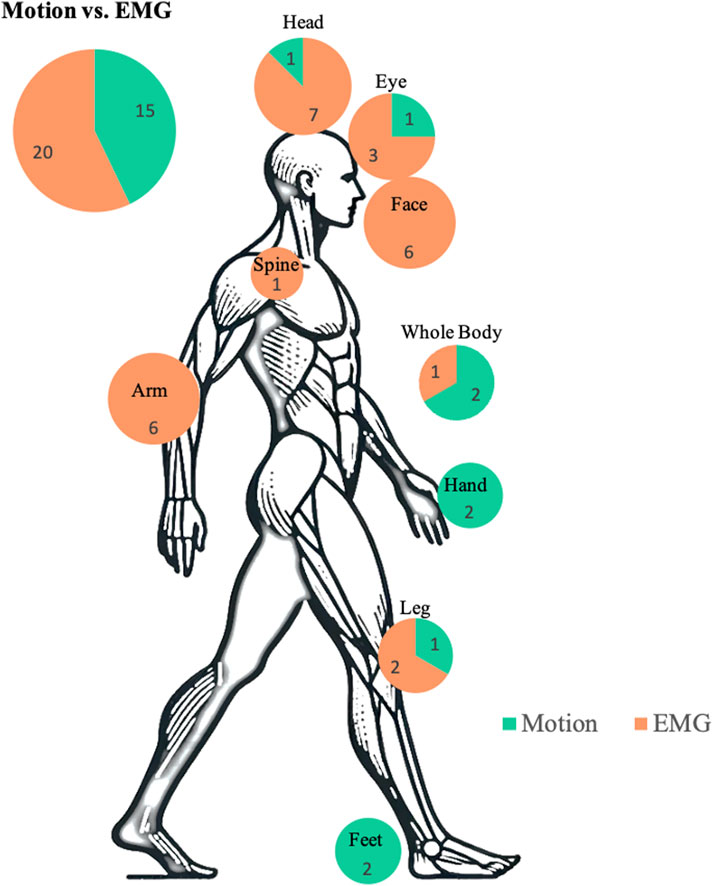
Figure 2. Placement of sensors in 29 studies using Motion tracking or EMG. The size of the circle represents the total number of studies for this body part. The number in the circle represents the number of both methods.
3.2 Questionnaire exploring the psychological side of the concept of presence
Questionnaires help to assess the overall effectiveness and impact of the VR intervention. By capturing immediate pre and post-exposure reactions, researchers can gain insight into the immersive quality of the VR experience, its usability, and its potential psychological impact.
3.2.1 Pre-task questionnaires
Pre-task questionnaires are common when examining VR presence and specific disorders or psychological conditions. 21 studies out of 78 (27% of studies, once the reviews are excluded) had participants take a pre-task questionnaire prior to experiencing a VR environment to determine baseline measurements in multiple domains. These domains included psychological state, specific symptoms or conditions, research of user personality traits, and expected level of engagement with the VR experience. Establishing a pre-experience baseline allows researchers to more accurately understand the underlying conditions of the participants and to attribute observed changes in physiological and psychological responses to the VR intervention itself.
A total of 22 questionnaires were used in the 21 articles with pre-task questionnaires. Their different usage statistics can be seen in Figure 3.
3.2.2 Post-task questionnaires
69 studies out of 78 of studies (88%) once the reviews are excluded) had participants take 136 post-task questionnaires of 54 types after experiencing a VR environment. The denomination and statistics of the 54 types of questionnaires of the VR experience are illustrated in Figure 4.
3.3 Physiological methods used to assess presence
ECG, EMG, motion tracking and EDA are the four main physiological measures used to quantify presence in VR, with additional physiological methods such as EEG, EOG. In most cases, several of these methods were used in combination with a questionnaire. Aggregated data from 78 studies in 94 articles from the relevant literature show a clear distribution of physiological methods used. As shown in Figure 5, ECG was used in 40% of the studies, followed by EDA (33%), EMG (17%) and motion monitoring (10%).
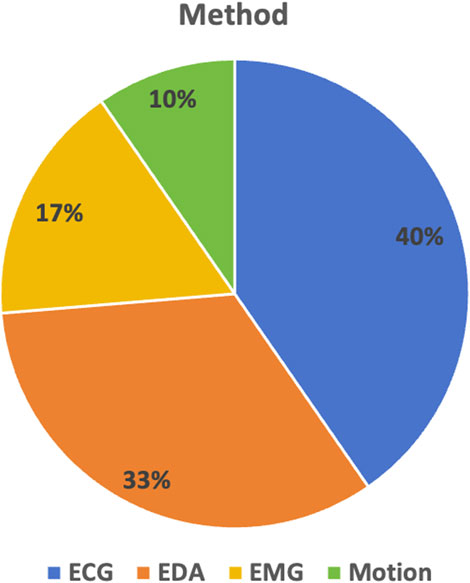
Figure 5. Using physiological measures in 78 studies of VR Presence from 2001 to 2025. These articles include at least one of the ECG, EDA, EMG, and Motion Tracking. Motion includes motion capture and IMU.
In the area of motion tracking, 11 studies out of 78 used two different methodologies: motion capture and IMUs. Specifically, one study used IMUs (Aykent et al., 2018) to capture head dynamics. Motion tracking captures and EMG were used in combination in three studies (Pallavicini et al., 2013; Orozco-Mora et al., 2022; Soler-Domínguez et al., 2020) to evaluate the user’s physical interactions and movements in the VR space. Finally, in addition to the four more prevalent quantitative methods described above (ECG, EMG, motion tracking and EDA), EEG and EOG were also used to assess presence in VR (Baker et al., 2020; Oliveira et al., 2024; Lehoux et al., 2024; Moinnereau et al., 2022; Gougeh and Falk, 2022; Saha et al., 2024).
The frequency and distribution of these six physiological methods are illustrated in Figure 6, providing a broader perspective on the various approaches to capturing the multidimensional nature of engagement in VR.
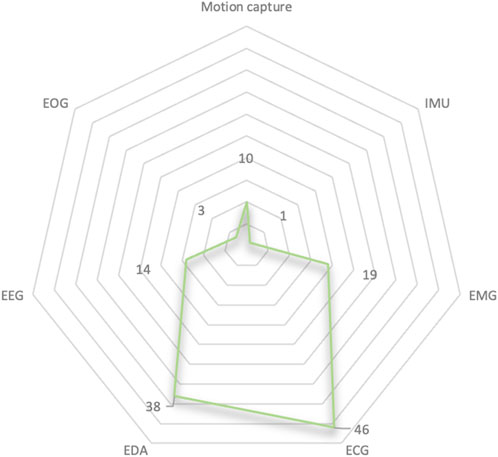
Figure 6. The seven physiological measurements commonly used to assess VR Presence in the 78 articles retained for our review.
3.4 How physiological methods were combined to assess presence?
We observed significant differences in the combination of methods used to assess presence (Pallavicini et al., 2013; Philipp et al., 2012). In 94% of the studies, more than one method was used. The different combinations of physiological variables are shown in Figure 7. “Questionnaires, ECG, EDA” was the most common combination, accounting for 21% of the total number of studies (Woodall and Hollis, 2024; Leite et al., 2019; Slater et al., 2003; Ahmad et al., 2023; Slater et al., 2009; Barreda-Ángeles et al., 2021; Caldas et al., 2023; Steinicke et al., 2009; Meehan et al., 2002; Rachevsky et al., 2018; Ranasinghe et al., 2018; Rodríguez et al., 2011; Pavic et al., 2024; Neumann et al., 2024; Espinola et al., 2024), It emphasizes the interdisciplinary approach to presence research in VR, combining subjective reports and objective physiological measures for a more complete understanding of the user experience.
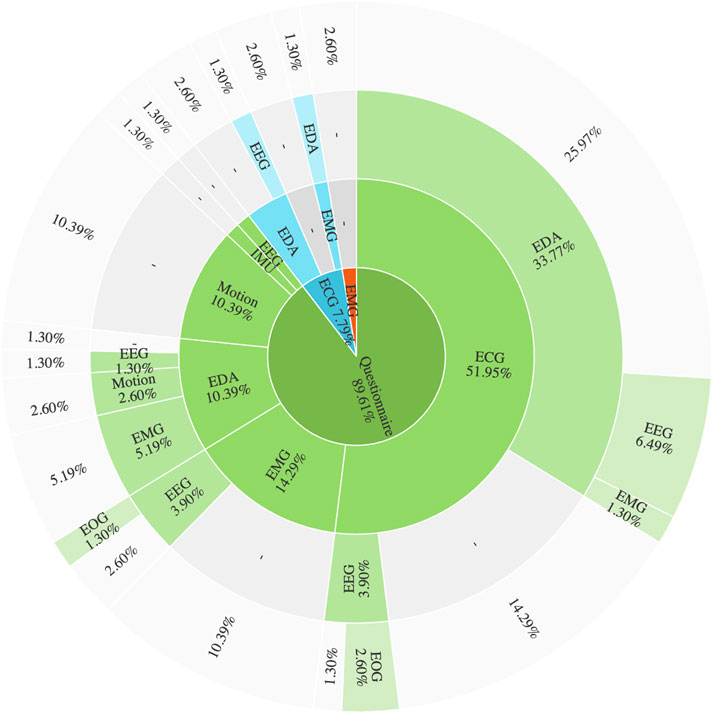
Figure 7. The combinations of methods used to assess VR Presence in 78 studies. The core parts distinguish between studies using subjective questionnaire methods and those relying exclusively on physiological measures. Progressing outwards, each layer represents a different combination of methods based on the previous layer, and the outermost layer depicts the relative frequency of use of each combination of methods in the analyzed articles. Each study used between one and four methods in assessing VR Presence.
3.5 Number of participants per study
The 78 articles were classified into three categories, depending whether EMG, ECG and motion capture was used. The number of participants largely varied with a mean number of volunteers of 29 in the 11 studies mostly interested by motor control in VR, 54 in the 17 studies focusing on EMG recordings, and 36 in 43 studies recording the ECG (see Figure 8). This variability in sample sizes is a good example of the large methodological diversity within the field.
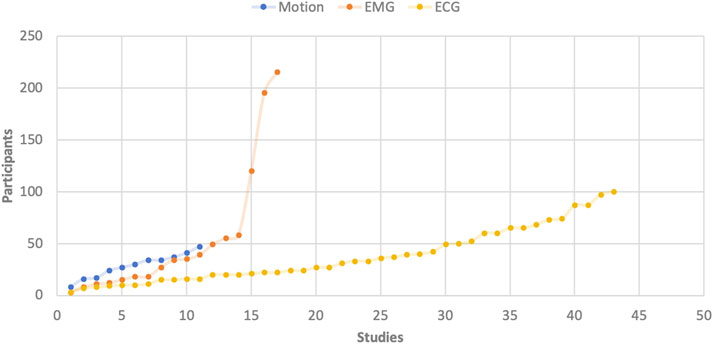
Figure 8. Distribution of participant sample sizes across VR studies. This figure illustrates the variation in participant numbers across the examined studies in the form of a scatterplot, reflecting the tailored study design approach that is commonly used in VR research. Each point represents a unique study, plotted according to sample size and study identification number. The horizontal axis represents the number of participants and the vertical axis represents studies using different methods.
The variability in sample sizes across these methodologies suggests differing research strategies tailored to the objectives of each study. This variability may be indicative of an intentional design choice by researchers to balance the depth of individual participant data against the logistical constraints of managing larger participant groups. While larger samples may provide a broader basis for generalizing findings, smaller samples are often necessary for in-depth qualitative analyses or when employing complex, resource-intensive measurement techniques.
3.6 Methods
One set of methods focuses on analyzing questionnaire responses, including self-reported measures of presence, while a second set of methods examines physiological data and aims to correlate these measures with levels of VR presence.
3.6.1 Methods used to investigate the answers to the questionnaires
Among the 78 studies reviewed, 68 have integrated questionnaires, highlighting their pivotal role in assessing VR presence. These questionnaires are designed to capture the participants’ self-reported experiences, perceptions, and reactions within VR environments. The analysis of this self-reported data is critical for understanding the subjective dimensions of presence, including emotional responses, perceived realism, and the sense of being ‘transported’ into the virtual environment. The methods used to analyze the answers to the questionnaires are illustrated in Figure 9.
○ Analysis of Variance (ANOVA) Methods: ANOVA serves as a foundational statistical approach to discern differences among group means. Its variations cater to diverse experimental designs. Simple one-way ANOVA, applied in seven studies (Dias et al., 2014; Ahmad et al., 2023; Orozco-Mora et al., 2022; Neumann et al., 2024; Ganapathi and Sorathia, 2023; Radhakrishnan et al., 2024), tests for differences across single independent variables. Meanwhile, 13 studies (Baker et al., 2020; Schuurink et al., 2008; Oliveira et al., 2024; Leite et al., 2019; Slater et al., 2009; Moinnereau et al., 2022; Caldas et al., 2023; Kalansooriya et al., 2016; Blanchard et al., 2024) have opted for the more general ANOVA, likely to test multi-level factors. Repeated measures ANOVA, cited in 16 studies (Anheuer et al., 2024; Pallavicini et al., 2013; Oliveira et al., 2024; Ahmad et al., 2023; Gougeh and Falk, 2022; Philipp et al., 2012; Meehan et al., 2002; Espinola et al., 2024; Ríos et al., 2018; Wang et al., 2022; Kampa et al., 2022), evaluates conditions that involve the same participants across multiple treatments, providing a rigorous approach to control for within-subject variability. Fewer studies have employed more complex models such as two-way ANOVA (2 studies) (Lehoux et al., 2024; Antley and Slater, 2011) and 2 × 2 ANOVA (1 study) (Bektaş et al., 2021), which accommodate interactions between two independent variables.
○ Descriptive and Inferential Statistics: Descriptive statistics were prominently used in 22 studies (Martens et al., 2019; Ahmad et al., 2023; Aykent et al., 2018; Soler-Domínguez et al., 2020; Caldas et al., 2023; Steinicke et al., 2009; Rachevsky et al., 2018; Ranasinghe et al., 2018; Ganapathi and Sorathia, 2023; Wang et al., 2022; Kim et al., 2018; Lee et al., 2021; Dey et al., 2020; Zuniga et al., 2021) to summarize data features, such as central tendency and variability. They provide a straightforward interpretation of data distributions and are often preliminary steps in data analysis. Inferential statistical tests, which extrapolate findings beyond the sample to a larger population, are also noted for their limited yet focused application in two of the studies (Wang et al., 2022; Lee et al., 2021). Emerging analytical trends are found with machine learning methodologies in six studies (Lehoux et al., 2024; Orozco-Mora et al., 2022; Rachevsky et al., 2018; Pavic et al., 2024; Alsuradi H and Eid M (2022); Shumailov and Gunes, 2017), which suggests a progressive move towards utilizing complex algorithms to detect patterns and predict outcomes in VR presence research.
○ Non-parametric Tests: Given their ability to make inferences without relying on distributional assumptions, non-parametric tests have a critical place in VR presence research. The Kruskal–Wallis test (6 studies) (Gromer et al., 2019; Orozco-Mora et al., 2022; Pavic et al., 2024; Souza et al., 2018; Gonçalves et al., 2023; Schöne et al., 2023) and the Mann–Whitney U test (5 studies) (Slater et al., 2003; Aykent et al., 2018; Gonçalves et al., 2023; Schöne et al., 2023; Kisker et al., 2021) are prevalent, providing robust alternatives to t-tests and ANOVAs when data do not meet parametric assumptions. The presence of other non-parametric methods, such as the Friedman test (3 study) (Rodríguez et al., 2011; Kisker et al., 2021; Feigl et al., 2019) and Wilcoxon tests (3 studies) (Rodríguez et al., 2011; Kisker et al., 2021; Feigl et al., 2019), underscores their utility in handling ordinal data or small sample sizes.
○ Regression and Correlation Analyses: Correlation analyses, observed in 11 studies (Anheuer et al., 2024; Ahmed et al., 2017; Oliveira et al., 2024; Radhakrishnan et al., 2024; Lee et al., 2021; Gonçalves et al., 2023; Ohashi et al., 2018; Beeli et al., 2008; Schirm et al., 2019; Wriessnegger et al., 2022; Sarasso et al., 2024), reveal the degree to which variables move in tandem, offering insights into the relationships between different aspects of VR presence. Regression analyses, although sparsely represented (2 studies) (Baker et al., 2020; Barreda-Ángeles et al., 2021), allow for the prediction of one variable based on another, indicating causal relationships that can be key to understanding how various factors contribute to the sense of presence.
○ T-tests and Related Corrections: T-tests are crucial for comparing two groups. Our review finds them utilized in eight studies (Anheuer et al., 2024; Ahmed et al., 2017; Gromer et al., 2019; Kim et al., 2018; Dey et al., 2020; Zuniga et al., 2021; Borrego et al., 2016; Felnhofer et al., 2014), suggesting their importance in assessing the impact of specific interventions on presence. Paired t-tests (3 studies) (Woodall and Hollis, 2024; Athif et al., 2020; Wirth et al., 2018) compare related samples such as the same individuals before and after VR exposure. Corrections for t-tests, such as the Greenhouse-Geisser correction (2 studies) (Ahmad et al., 2023; Gougeh and Falk, 2022), adjust for assumptions violations, ensuring the validity of the statistical inference.
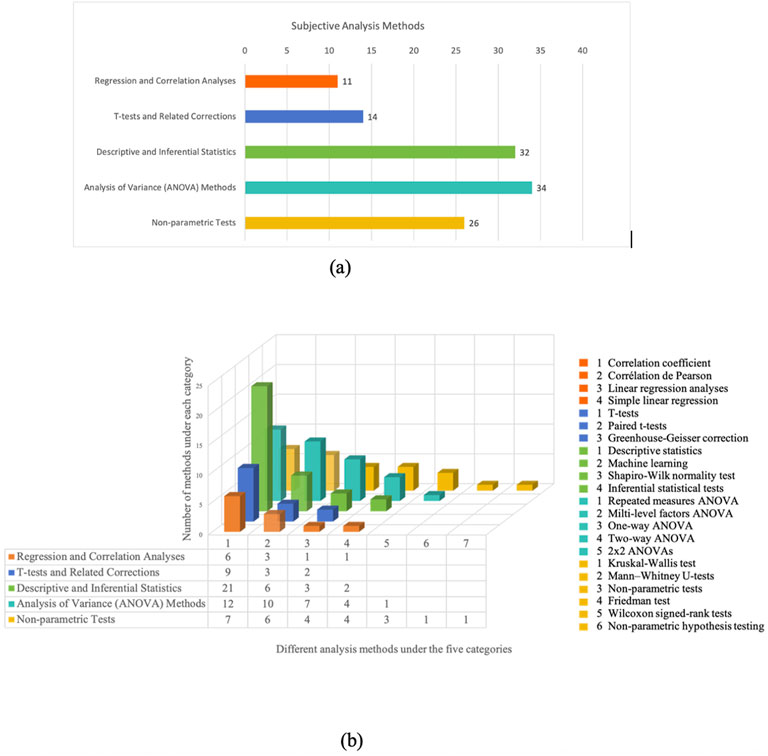
Figure 9. Distribution of methods used to analyze subjective questionnaire results in the VR Presence study. (a) Subjective analysis methods. The vertical axis of the stereogram classifies these methods into analysis of variance (ANOVA) methods, descriptive and inferential statistics, non-parametric tests, regression and correlation analyses, and t-tests and correlation corrections. (b) Anlysis methods under the five categories. The rectangular bars in the horizontal axis of each column represent the specific research method. The height of each rectangle represents the number of studies using the corresponding type of method.
3.6.2 Methods used to investigate results of the neurophysiological and behavioral data
The Methods used to investigate results of the neurophysiological and behavioral data intend to assess objectively presence in VR environments. They aim to correlate physical responses with different levels of immersion and engagement, providing a biophysical perspective on presence. They are summarized in Figure 10.
○ Descriptive and Inferential Statistics: Descriptive statistics are foundational in data analysis, employed in 17 studies to summarize key characteristics such as means, standard deviations, and frequency distributions. These statistics offer an initial overview of the physiological data patterns. Inferential statistics, though utilized in a more targeted manner (1 study) (Marín-Morales et al., 2021) for hypothesis testing and two studies (Dias et al., 2014; Rodríguez et al., 2011) for statistical analyses, play a crucial role in drawing conclusions about the broader implications of these patterns.
○ ANOVA and Variance Analysis: ANOVA is a fundamental method for comparing mean values across multiple groups and conditions. Our review found 15 studies (Anheuer et al., 2024; Baker et al., 2020; Dias et al., 2014; Lehoux et al., 2024; Gromer et al., 2019; Orozco-Mora et al., 2022; Pavic et al., 2024; Espinola et al., 2024; Ganapathi and Sorathia, 2023; Radhakrishnan et al., 2024; Ríos et al., 2018; Wang et al., 2022; Felnhofer et al., 2014; Quezada-Scholz et al., 2022; Fadeev et al., 2020) employing ANOVA to test for differences across various VR interventions, indicating its importance in the field. Repeated Measures ANOVA, used in 12 studies (Anheuer et al., 2024; Pallavicini et al., 2013; Oliveira et al., 2024; Leite et al., 2019; Saha et al., 2024; Philipp et al., 2012; Espinola et al., 2024; Blanchard et al., 2024; Kampa et al., 2022; Beeli et al., 2008; Felnhofer et al., 2014; Sehrt et al., 2023), addresses scenarios involving repeated observations of the same subjects. The application of Three-Way Factorial ANOVA (1 study) (Philipp et al., 2012) and Mixed ANOVA (1 study) (Steinicke et al., 2009) suggest the complexity of some experimental designs that explore interactions among multiple independent variables.
○ T-tests and Non-parametric Tests: The T-test, appearing in 16 studies (Anheuer et al., 2024; Ahmed et al., 2017; Baker et al., 2020; Schuurink et al., 2008; Lehoux et al., 2024; Caldas et al., 2023; Steinicke et al., 2009; Ranasinghe et al., 2018; Rodríguez et al., 2011; Kampa et al., 2022; Lee et al., 2021; Dey et al., 2020; Kisker et al., 2021; Athif et al., 2020; Fadeev et al., 2020; Yu et al., 2012), is commonly used to compare the means of two groups, providing insights into the effects of VR environments on physiological responses. Non-parametric tests, which do not assume data normality, include the Kruskal–Wallis Test (4 studies) (Orozco-Mora et al., 2022; Souza et al., 2018; Schöne et al., 2023; Hernández-Melgarejo et al., 2022) and the Friedman Test (3 studies) (Ranasinghe et al., 2018; Lee et al., 2021; Caputo et al., 2023). These tests are essential when the data do not meet the parametric assumptions required for T-tests, as they provide a robust alternative for comparative analysis.
○ Machine Learning: Machine Learning techniques are increasingly being adopted in VR presence studies, indicating a trend toward more sophisticated data analysis methods. Support Vector Machines (SVM), utilized in four studies (Ahmad et al., 2023; Orozco-Mora et al., 2022; Saha et al., 2024; Wirth et al., 2018), is a popular choice for classification problems, while other machine learning models, such as K-Nearest Neighbors (KNN) (Slater et al., 2009; Orozco-Mora et al., 2022; Saha et al., 2024; Radhakrishnan et al., 2024), Random Forest (Saha et al., 2024), and Multi-Layer Perceptron Classifiers (Saha et al., 2024), indicating the diversity of approaches tailored to specific research questions, demonstrate the burgeoning use of predictive modeling in this domain.
○ Signal and Data Processing: Signal processing techniques are imperative for extracting information from raw physiological data. Root Mean Square (RMS) processing, employed in two studies (Pavic et al., 2024; Ohashi et al., 2018), helps quantify the magnitude of a varying signal, which can be critical for understanding the intensity of physiological responses. Correlation analyses, including Pearson and Spearman’s, featured in three studies (Ahmed et al., 2017; Gougeh and Falk, 2022; Oliver and Hollis, 2021), assess the strength and direction of the linear relationships between different physiological measures
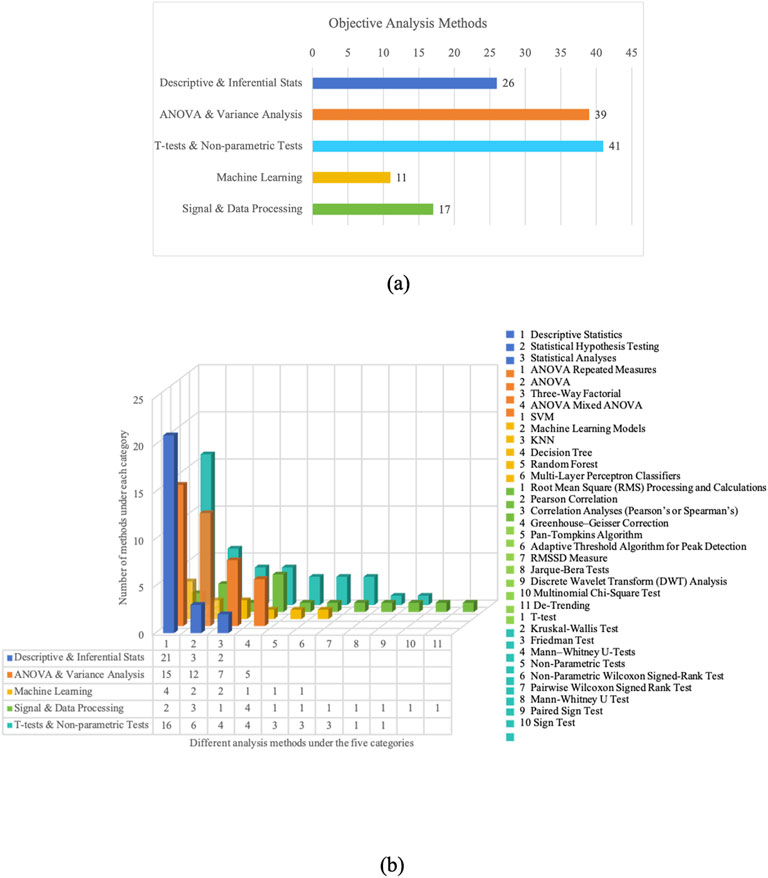
Figure 10. Distribution of methods used to analyze objective physiological measures in the VR Presence study. (a) Five analysis methods. The vertical axis of the stereogram classifies these methods into Descriptive and Inferential Stats, ANOVA and Variance Analysis, T-tests and Non-parametric Tests, Machine Learning, and Signal and Data Processing. (b) Anlysis methods under the five categories. The rectangular bars in the horizontal axis of each column represent the specific research method. The height of each rectangle represents the number of studies using the corresponding type of method.
4 Summary and discussion
In this review, 94 articles aiming to quantify presence in VR using physiological recordings between 2001 and 2025 were analyzed. Research questionnaires were also used in 88% of these articles.
Our analysis indicates a significant shift over time towards the use of various physiological measures, including movement analysis, ECG and EMG, to quantify presence in VR, suggesting an emphasis on physical engagement and interaction as indicators of presence. Similarly, EMG measurements have been used to assess emotional responses and levels of engagement, highlighting the role of muscle responses in reflecting immersion. ECG measures, focusing on stress and arousal, highlight the physiological aspects of presence, indicating that the heart’s response to VR environments would be a key factor in understanding immersion in VR.
It remains that the combination of subjective questionnaires and objective physiological data appears to be a powerful approach for comprehensively assessing presence in VR. It allows a richer interpretation of presence by combining self-reported experiences with measurable physiological responses. The correlation between subjective feelings of immersion and objective signs of engagement or stress provides a more nuanced understanding of presence. It highlights the complexity of the VR experience, which encompasses not only cognitive and emotional responses, but also physical reactions.
The review highlights also an emerging trend to leverage advanced data analytics and machine learning to interpret complex physiological datasets. This approach has shown promise in identifying patterns and correlations in the data, leading to a better understanding of the mechanisms of presence in VR. In addition, the trend towards real-time data analysis suggests the development of adaptive VR environments that respond to the physiological state of the user, which could enhance immersion and personalize the VR experience. The interdisciplinary approach, which combines insights from psychology, neuroscience, computer science and other fields, enriches our understanding of presence in VR, suggesting a multifaceted pathway for exploring immersion in VR. The integration of physiological measures with traditional questionnaires, combined with advanced analytical methodologies, marks a significant advance in our understanding of VR technologies. These developments not only contribute to the scientific study of presence in VR, but also have practical implications for the design of more immersive, interactive and personalized VR experiences.
That said we would like to raise three issues to end up the discussion:
○ First, we would like to discuss the very nature of the neurophysiological variables recorded to detect the presence in VR by briefly reminding the characteristics of the autonomic nervous system (ANS). The ANS is divided into sympathetic and parasympathetic systems. The sympathetic system is known as ‘fight or flight’ and the parasympathetic component as ‘rest and digest’. Two aspects of the ANS function as opposing functions that act to achieve homeostasis. It functions without conscious control. The following changes occur when the sympathetic nervous system is activated: Heart rate and heart muscle contractility increase, the ciliary muscle relaxes and the pupil dilates to improve distance vision, bronchodilation of the lungs, among other changes. These changes serve to increase movement and strength. The parasympathetic nervous system, also known as ‘rest and digest’, works in opposition to the sympathetic nervous system. Its functions include a decrease in heart rate and heart muscle contractility, and constriction of the ciliary muscle and pupil for close-up vision. Hence, the ANS (heart rate, respiratory rate, pupillary dilatation, skin conductance), the somatic motricity including the oculomotor system are collected as physiological markers of presence in VR. In particular there seems to be a broad spread expectancy of heart rate variability giving inference for presence (reviews of Grassini and Laumann, 2020; Halbig and Latoschik, 2021). The problem is that their recordings are also recommended as a means of quantifying stress (reviews of Taskasaplidis et al., 2024; Iqbal et al., 2022) and mental load (reviews of Tao et al., 2019; Ayres et al., 2021) to name but a few behavioral variables. Therefore, to put it plainly, none of the variables just mentioned can be considered as specific to VR presence. Once again, the conclusion would be that it is by combining physiological variables reflecting the activation of the sympathetic system, of the motor system and by using questionnaires that we can get closer to assessing presence in virtual reality.
○ Second, in the introduction we proposed that presence not only depends on immersion characteristics, but also varies with the perceptual motor style of a person, as defined in human neurophysiology, which who explain its large variability amongst individual. Also, all neurophysiologists who work on sensory-motor transformations, whether in animal models or in humans, learn that the more ecological the context in which they work and the more precise their measurements of behavior, the greater the differences between individuals. In other words, the question is not just to understand how, on the basis of multimodal representations influenced by context, we reconstruct a reality that enables us to act. It is also about understanding how different people reach different conclusions when it comes to regulating their motor control. In other words, each of us has our own perceptual-motor style (for a review, see Vidal and Lacquaniti, 2021; Vidal, 2025) and even more so in pathological states. The consequence is that the average of behaviors in a cohort can be misleading. Each person, when the control of gaze and posture is challenged, takes a different view of the risks to which she/he is exposed and therefore adopts different solutions to resolve the problem. This is why individual longitudinal monitoring is becoming a key element in the study of motor control. This is probably true for presence. Also, being a permanent biped is a risky game. For instance, uncertain prediction and/or the adoption of poor muscular synergies lead to a fall to the ground 500 m later, around 700 m after the start of a postural perturbation. Incidentally, falls are the second leading cause of death by unintentional trauma in the world, not to mention the various injuries they cause and the loss of independence of the elderly. Hence, sensorimotor transformations, far from being a series of reflexes, is a question of ultra-rapid bets, not predictions, to assess the risks, and the optimal motor programs aiming to avoid them. These strategies have communalities between individuals (we rarely bet at random). They also define different styles for different individuals and unreasonable betting leads to neuroses (acrophobia, fear of falling). These considerations may be of interest together with the concept of perceptive style to understand why presence is so variable in VR environment. Again, individual longitudinal monitoring should become the rule.
○ Third, given the highly heterogeneous nature of the studies we reviewed, both in terms of methods, number of participants and analysis, larger prospective studies that follow best practice recommendations for obtaining and reporting presence data are needed.
Author contributions
DW: Writing – original draft, Writing – review and editing. YP: Writing – original draft, Writing – review and editing. LH: Writing – review and editing. NV: Writing – review and editing. P-PV: Supervision, Writing – review and editing.
Funding
The author(s) declare that no financial support was received for the research and/or publication of this article.
Conflict of interest
The authors declare that the research was conducted in the absence of any commercial or financial relationships that could be construed as a potential conflict of interest.
Generative AI statement
The author(s) declare that no Generative AI was used in the creation of this manuscript.
Publisher’s note
All claims expressed in this article are solely those of the authors and do not necessarily represent those of their affiliated organizations, or those of the publisher, the editors and the reviewers. Any product that may be evaluated in this article, or claim that may be made by its manufacturer, is not guaranteed or endorsed by the publisher.
Supplementary material
The Supplementary Material for this article can be found online at: https://www.frontiersin.org/articles/10.3389/frvir.2025.1530770/full#supplementary-material
References
Ahmad, Z., Rabbani, S., Zafar, M. R., Ishaque, S., Krishnan, S., and Khan, N. (2023). Multilevel stress assessment from ECG in a virtual reality environment using multimodal fusion. IEEE Sensors J. 23 (23), 29559–29570. doi:10.1109/JSEN.2023.3323290
Ahmed, I., Harjunen, V., Jacucci, G., Ravaja, N., and Spapé, M. M. (2017). Total immersion: designing for affective symbiosis in a virtual reality game with haptics, biosensors, and emotive agents. Revis. Sel. Pap. 5, 23–37. doi:10.1007/978-3-319-57753-1_3
Alsuradi, H., and Eid, M. (2022). An ensemble deep learning approach to evaluate haptic delay from a single trial EEG data. Front. Robot. AI 9, 1013043. doi:10.3389/frobt.2022.1013043
Amini Gougeh, R., and Falk, H. T. (2023). Towards instrumental quality assessment of multisensory immersive experiences using a biosensor-equipped head-mounted display. Qual. User Exp. 8 (1), 9. doi:10.1007/s41233-023-00062-7
Anheuer, D., Karacan, B., Herzog, L., Weigel, N., Meyer-Nieberg, S., Gebhardt, T., et al. (2024). * framework for microdosing odors in virtual reality for psychophysiological stress training. Sensors Basel, Switz. 24 (21), 7046. doi:10.3390/s24217046
Antley, A., and Slater, M. (2011). The effect on lower spine muscle activation of walking on a narrow beam in virtual reality. IEEE Trans. Vis. Comput. Graph. 17 (2), 255–259. doi:10.1109/TVCG.2010.26
Athif, M., Rathnayake, K. B. L., Nagahapitiya, S. S. B., Samarasinghe, K. S. A., Samaratunga, S. P., Peiris, L. R., et al. (2020). Using biosignals for objective measurement of presence in virtual reality environments. Med. Biol. Soc. 2020, 3035–3039. doi:10.1109/EMBC44109.2020.9176022
Aykent, B., Chardonnet, -R. J., Merienne, F., and Kemeny, A. (2018). Angular velocity perception threshold and sense of presence for a three degrees of freedom (DOF). Driving simulator in virtual environment. SAE Tech. Pap. doi:10.4271/2018-01-5043
Ayres, P., Lee, Y. J., Paas, F., and Van Merriënboer, G. J. J. (2021). The validity of physiological measures to identify differences in intrinsic cognitive load. Front. Psychol. 12, 702538. doi:10.3389/fpsyg.2021.702538
Baker, C., Pawling, R., and Fairclough, S. (2020). Assessment of threat and negativity bias in virtual reality. Sci. Rep. 10 (1), 17338. doi:10.1038/s41598-020-74421-1
Barreda-Ángeles, M., Aleix-Guillaume, S., and Pereda-Baños, A. (2021). Virtual reality storytelling as a double-edged sword: immersive presentation of nonfiction 360-video is associated with impaired cognitive information processing. Commun. Monogr. 88 (2), 154–173. doi:10.1080/03637751.2020.1803496
Beeli, G., Casutt, G., Baumgartner, T., and Jäncke, L. (2008). Modulating presence and impulsiveness by external stimulation of the brain. Behav. Brain Funct. 4 (1), 33. doi:10.1186/1744-9081-4-33
Bektaş, K., Thrash, T., van Raai, A. M., Künzler, P., and Hahnloser, R. (2021). The systematic evaluation of an embodied control interface for virtual reality. PloS One 16 (12), e0259977. doi:10.1371/journal.pone.0259977
Blanchard, E. E., Trost, Z., Brown, M. R., Shum, C., and Meese, M. (2024). * Combining stress inoculation with virtual reality simulation training of malignant hyperthermia. Adv. Simul. Lond. Engl. 9 (1), 35. doi:10.1186/s41077-024-00308-0
Borrego, A., Latorre, J., Llorens, R., Alcañiz, M., and Noé, E. (2016). Feasibility of a walking virtual reality system for rehabilitation: objective and subjective parameters. J. NeuroEngineering Rehabilitation 13 (1), 68. doi:10.1186/s12984-016-0174-1
Caldas, O., Mauledoux, M., Aviles Sanchez, O., and Rodriguez-Guerrero, C. (2023). Breaking presence in immersive virtual reality toward behavioral and emotional engagement. SSRN Electron. J. doi:10.2139/ssrn.4374165
Caputo, A., Zancanaro, M., and Giachetti, A. (2023). “Eyes on teleporting: comparing locomotion techniques in virtual reality with respect to presence, sickness and spatial orientation,” in Human computer interaction INTERACT 2023. Editors M. Lárusdóttir, H. Petrie, A. Piccinno, and M. Winckler (Nature Switzerland: Springer), 547–566. doi:10.48550/arXiv.2312.09737
Dey, A., Phoon, J., Saha, S., Dobbins, C., and Billinghurst, M. (2020). “A neurophysiological approach for measuring presence in immersive virtual environments,” in 2020 IEEE international symposium on mixed and augmented reality (ISMAR), 474–485. doi:10.1109/ISMAR50242.2020.00072
Dias, J., Eloy, S., Carreiro, M., Proença, P., Moural, A., Costa, T., et al. (2014). “Designing better spaces for people: virtual reality and biometric sensing as tools to evaluate space use,” in Designing better spaces for people: virtual reality and biometric sensing as tools to evaluate space use, 739–748. doi:10.52842/conf.caadria.2014.739
Espinola, C. W., Nguyen, B., Torres, A., Sim, W., Rueda, A., Beavers, L., et al. (2024). * digital interventions for stress among frontline health care workers: results from a pilot feasibility cohort trial. JMIR Serious Games 12, e42813. doi:10.2196/42813
Fadeev, A. K., Smirnov, S. A., Zhigalova, P. O., Bazhina, S. P., Tumialis, V. A., and Golokhvast, S. K. (2020). Too real to Be virtual: autonomic and EEG responses to extreme stress scenarios in virtual reality. Behav. Neurol. 2020, 1–11. doi:10.1155/2020/5758038
Feigl, T., Roth, D., Gradl, S., Wirth, M., Latoschik, E. M., Eskofier, M. B., et al. (2019). Sick moves! Motion parameters as indicators of simulator sickness. IEEE Trans. Vis. Comput. Graph. 25 (11), 3146–3157. doi:10.1109/TVCG.2019.2932224
Felnhofer, A., Kothgassner, D. O., Hetterle, T., Beutl, L., Hlavacs, H., and Kryspin-Exner, I. (2014). Afraid to Be there? Evaluating the relation between presence, self-reported anxiety, and heart rate in a virtual public speaking task. Cyberpsychology, Behav. Soc. Netw. 17 (5), 310–316. doi:10.1089/cyber.2013.0472
Ganapathi, P., and Sorathia, K. (2023). User elicited gesture-based locomotion techniques for immersive VEs in a seated position: a comparative evaluation. Front. Virtual Real. 4. doi:10.3389/frvir.2023.1169654
Gonçalves, A., Montoya, M., Llorens, R., and Bermúdez i Badia, S. (2023). A virtual reality bus ride as an ecologically valid assessment of balance: a feasibility study. Virtual Real. 27 (1), 109–117. doi:10.1007/s10055-021-00521-6
Gougeh, R. A., and Falk, T. H. (2022). Multisensory immersive experiences: a pilot study on subjective and instrumental human influential factors assessment. 2022 14th international conference on quality of multimedia experience (QoMEX), 1–6.
Grassini, S., and Laumann, K. (2020). Questionnaire measures and physiological correlates of presence: a systematic review. Front. Psychol. 11, 349. doi:10.3389/fpsyg.2020.00349
Gromer, D., Reinke, M., Christner, I., and Pauli, P. (2019). Causal interactive links between presence and fear in virtual reality height exposure. Front. Psychol. 10, 141. doi:10.3389/fpsyg.2019.00141
Halbig, A., and Latoschik, E. M. (2021). A systematic review of physiological measurements, factors, methods, and applications in virtual reality. Front. Virtual Real. 2. doi:10.3389/frvir.2021.694567
Hein, D., Mai, C., and Hußman, H. (2018). “The usage of presence measurements in research: a review,” in Proceedings of the international society for presence research.
Hernández-Melgarejo, G., Luviano-Juárez, A., and Fuentes-Aguilar, R. Q. (2022). A framework to model and control the state of presence in virtual reality systems. IEEE Trans. Affect. Comput. 13 (4), 1854–1867. doi:10.1109/TAFFC.2022.3195697
Huber, G. (2008). Pour une métaphysique de la présence. Les. études Philos. 4, 451–461. doi:10.3917/leph.084.0451
Iqbal, T., Simpkin, J. A., Roshan, D., Glynn, N., Killilea, J., Walsh, J., et al. (2022). Stress monitoring using wearable sensors: a pilot study and stress-predict dataset. Sensors 22 (21), 8135. doi:10.3390/s22218135
Kalansooriya, P., Mitsui, Y., Takaki, S., Kinefuchi, M., Takahashi, A., and Nomura, S. (2016). The effect of a bio-signal interactive virtual reality on subjective impression—a preliminary study. Int. J. Affect. Eng. 15 (3), 317–323. doi:10.5057/ijae.IJAE-D-16-00004
Kampa, M., Finke, J., Stalder, T., Bucher, L., Klapperich, H., Mertl, F., et al. (2022). Facilitating relaxation and stress reduction in healthy participants through a virtual reality intervention: study protocol for a non-inferiority randomized controlled trial. Trials 23 (1), 380. doi:10.1186/s13063-022-06307-8
Kim, G., and Biocca, F. (2018). “Immersion in virtual reality can increase exercise motivation and physical performance,” in Virtual, augmented and mixed reality: applications in health, cultural heritage, and industry. Editors J. C. Chen,, and G. Fragomeni (Springer International Publishing), 94–102. doi:10.1007/978-3-319-91584-5_8
Kisker, J., Gruber, T., and Schöne, B. (2021). Behavioral realism and lifelike psychophysiological responses in virtual reality by the example of a height exposure. Psychol. Res. 85 (1), 68–81. doi:10.1007/s00426-019-01244-9
Lee, M., Kolkmeier, J., Heylen, D., and Ijsselsteijn, W. (2021). Who makes your heart beat? What makes you sweat? Social conflict in virtual reality for educators. Front. Psychol. 12, 628246. doi:10.3389/fpsyg.2021.628246
Lehoux, T., Capobianco, A., Lacoste, J., Rollier, S., Mopsus, Y., Melgire, M., et al. (2024). * Virtual reality cue-exposure therapy in reducing cocaine craving: the Promoting Innovative COgnitive behavioral therapy for Cocaine use disorder (PICOC) study protocol for a randomized controlled trial. Trials 25 (1), 421. doi:10.1186/s13063-024-08275-7
Leite, S., Dias, S. M., Eloy, S., Freitas, J., Marques, S., Pedro, T., et al. (2019). Physiological arousal quantifying perception of safe and unsafe virtual environments by older and younger adults. Sensors 19 (11), 2447. doi:10.3390/s19112447
Mantilla, J., Wang, D., Bargiotas, I., Wang, J., Cao, J., Oudre, L., et al. (2020). Motor style at rest and during locomotion in humans. J. Neurophysiology 123 (6), 2269–2284. doi:10.1152/jn.00019.2019
Marín-Morales, J., Higuera-Trujillo, L. J., Guixeres, J., Llinares, C., Alcañiz, M., and Valenza, G. (2021). Heart rate variability analysis for the assessment of immersive emotional arousal using virtual reality: comparing real and virtual scenarios. PLOS ONE 16 (7), e0254098. doi:10.1371/journal.pone.0254098
Martens, A. M., Antley, A., Freeman, D., Slater, M., Harrison, J. P., and Tunbridge, M. E. (2019). It feels real: physiological responses to a stressful virtual reality environment and its impact on working memory. J. Psychopharmacol. 33 (10), 1264–1273. doi:10.1177/0269881119860156
Meehan, M., Insko, B., Whitton, M., and Brooks, P. F. (2002). Physiological measures of presence in stressful virtual environments. ACM Trans. Graph. 21 (3), 645–652. doi:10.1145/566654.566630
Moinnereau, M., Oliveira, A., and Falk, T. H. (2022). “Human influential factors assessment during at-home gaming with an instrumented VR headset,” in 2022 14th international conference on quality of multimedia experience (QoMEX), 1–4. doi:10.1109/QoMEX55416.2022.9900912
Neumann, I., Andreatta, M., Pauli, P., and Käthner, I. (2024). * Social support of virtual characters reduces pain perception. Eur. J. Pain London, Engl. 28 (5), 806–820. doi:10.1002/ejp.2220
Ohashi, I., Kotani, K., Suzuki, S., Asao, T., and Harada, T. (2018). “Comparison of electromyogram during ball catching task in haptic VR and real environment,” in Human interface and the management of information. Interaction, visualization, and analytics. Editors S. Yamamoto,, and H. Mori (Springer International Publishing), 415–425. doi:10.1007/978-3-319-92043-6_35
Oliveira, J., Aires Dias, J., Correia, R., Pinheiro, R., Reis, V., Sousa, D., et al. (2024). * exploring immersive multimodal virtual reality training, affective states, and ecological validity in healthy firefighters: quasi-experimental study. JMIR Serious Games 12, e53683. doi:10.2196/53683
Oliver, H. J., and Hollis, H. J. (2021). Virtual reality as a tool to study the influence of the eating environment on eating behavior: a feasibility study. Foods 10 (1), 89. doi:10.3390/foods10010089
Orozco-Mora, C. E., Oceguera-Cuevas, D., Fuentes-Aguilar, R. Q., and Hernández-Melgarejo, G. (2022). Stress level estimation based on physiological signals for virtual reality applications. IEEE Access 10, 68755–68767. doi:10.1109/ACCESS.2022.3186318
Pallavicini, F., Cipresso, P., Raspelli, S., Grassi, A., Serino, S., Vigna, C., et al. (2013). Is virtual reality always an effective stressors for exposure treatments? Some insights from a controlled trial. BMC Psychiatry 13 (1), 52. doi:10.1186/1471-244X-13-52
Pavic, K., Vergilino-Perez, D., Gricourt, T., and Chaby, L. (2024). * Age-related differences in subjective and physiological emotion evoked by immersion in natural and social virtual environments. Sci. Rep. 14 (1), 15320. doi:10.1038/s41598-024-66119-5
Philipp, C. M., Storrs, R. K., and Vanman, J. E. (2012). Sociality of facial expressions in immersive virtual environments: a facial EMG study. Biol. Psychol. 91 (1), 17–21. doi:10.1016/j.biopsycho.2012.05.008
Pianzola, F., Riva, G., Kukkonen, K., and Mantovani, F. (2022). Am I present in imaginary worlds? Intentions, actions, and flow in mediated experiences and fiction. Behav. Brain Sci. 45, e293. doi:10.1017/S0140525X2100220X
Quezada-Scholz, E. V., Laborda, A. M., San Martín, C., Miguez, G., Alfaro, F., Mallea, J., et al. (2022). Cued fear conditioning in humans using immersive Virtual Reality. Learn. Motivation 78, 101803. doi:10.1016/j.lmot.2022.101803
Rachevsky, C. D., de Souza, C. V., and Nedel, L. (2018). Visualization and interaction in immersive virtual reality games: a user evaluation study. 89–98. doi:10.1109/SVR.2018.00024
Radhakrishnan, U., Kuang, L., Koumaditis, K., Chinello, F., and Pacchierotti, C. (2024). * haptic feedback, performance and arousal: a comparison study in an immersive VR motor skill training task. IEEE Trans. Haptics 17 (2), 249–262. doi:10.1109/TOH.2023.3319034
Ranasinghe, N., Jain, P., Thi Ngoc Tram, N., Koh, R. K. C., Tolley, D., Karwita, S., et al. (2018). “Season traveller: multisensory narration for enhancing the virtual reality experience,” in Proceedings of the 2018 CHI conference on human factors in computing systems, 1–13. doi:10.1145/3173574.3174151
Ríos, A., Palomar, M., and Pelechano, N. (2018). “Users’ locomotor behavior in collaborative virtual reality,” in Proceedings of the 11th ACM SIGGRAPH conference on motion, interaction and games. doi:10.1145/3274247.3274513
Riva, G. (2018). The neuroscience of body memory: from the self through the space to the others. Cortex 104, 241–260. doi:10.1016/j.cortex.2017.07.013
Rodríguez, A., Rey, B., and Alcañiz, M. (2011). Immersive virtual environments for emotional engineering: description and preliminary results. Stud. Health Technol. Inf. 167, 199–203. doi:10.3233/978-1-60750-766-6-199
Saha, S., Dobbins, C., Gupta, A., and Dey, A. (2024). * Machine learning based classification of presence utilizing psychophysiological signals in immersive virtual environments. Sci. Rep. 14 (1), 21667. doi:10.1038/s41598-024-72376-1
Sarasso, P., Ronga, I., Piovesan, F., Barbieri, P., Del Fante, E., De Luca, D., et al. (2024). * Shared attention in virtual immersive reality enhances electrophysiological correlates of implicit sensory learning. Sci. Rep. 14 (1), 3767. doi:10.1038/s41598-024-53937-w
Schirm, J., Tullius, G., and Habgood, J. (2019). “Towards an objective measure of presence: examining startle reflexes in a commercial virtual reality game,” in Extended abstracts of the annual symposium on computer-human interaction in play companion extended abstracts, 671–678. doi:10.1145/3341215.3356263
Schöne, B., Kisker, J., Lange, L., Gruber, T., Sylvester, S., and Osinsky, R. (2023). The reality of virtual reality. Front. Psychol. 14, 1093014. doi:10.3389/fpsyg.2023.1093014
Schuemie, M. J., Peter, V. D. S., Krijn, M., and van der Mast, C. A. (2001). Research on presence in virtual reality: a survey. CyberPsychology and Behav. 4 (2), 183–201. doi:10.1089/109493101300117884
Schuurink, L. E., Houtkamp, J., and Toet, A. (2008). “Engagement and EMG in serious gaming: experimenting with sound and dynamics in the levee patroller training game,” in Fun and games. Editors B. Ruyter, W. IJsselsteijn, and D. Rowland (Springer Berlin Heidelberg), 139–149.
Sehrt, J., Wißmann, T., Breitenbach, J., and Schwind, V. (2023). The effects of body location and biosignal feedback modality on performance and workload using electromyography in virtual reality. Proc. 2023 CHI Conf. Hum. Factors Comput. Syst., 1–16. doi:10.1145/3544548.3580738
Shumailov, I., and Gunes, H. (2017). “Computational analysis of valence and arousal in virtual reality gaming using lower arm electromyograms,” in 2017 seventh international conference on affective computing and intelligent interaction (ACII), 164–169. doi:10.1109/ACII.2017.8273595
Slater, M., Brogni, A., and Steed, A. (2003). “Physiological responses to breaks in presence: a pilot study. 157,” in The 6th annual international workshop on presence.
Slater, M., Khanna, P., Mortensen, J., and Yu, I. (2009). Visual realism enhances realistic response in an immersive virtual environment. IEEE Comput. Graph. Appl. 29 (3), 76–84. doi:10.1109/MCG.2009.55
Soler-Domínguez, L. J., de Juan, C., Contero, M., and Alcañiz, M. (2020). I walk, therefore I am: a multidimensional study on the influence of the locomotion method upon presence in virtual reality. J. Comput. Des. Eng. 7 (5), 577–590. doi:10.1093/jcde/qwaa040
Souza, V. C. d., Nedel, L., Kopper, R., Maciel, A., and Tagliaro, L. (2018). “The effects of physiologically-adaptive virtual environment on user’s sense of presence,” in 2018 20th symposium on virtual and augmented reality (SVR), 133–142. doi:10.1109/SVR.2018.00029
Steinicke, F., Bruder, G., Hinrichs, K., Steed, A., and Gerlach, A. L. (2009). “Does a gradual transition to the virtual world increase presence?,” in IEEE virtual reality conference, 203–210. doi:10.1109/VR.2009.4811024
Tao, D., Tan, H., Wang, H., Zhang, X., Qu, X., and Zhang, T. (2019). A systematic review of physiological measures of mental workload. Int. J. Environ. Res. Public Health 16 (15), 2716. doi:10.3390/ijerph16152716
Taskasaplidis, G., Fotiadis, A. D., and Bamidis, D. P. (2024). Review of stress detection methods using wearable sensors. IEEE Access 12, 38219–38246. doi:10.1109/ACCESS.2024.3373010
Triberti, S., Sapone, C., and Riva, G. (2025). Being there but where? Sense of presence theory for virtual reality applications. Humanit Soc. Sci. Commun12 79, 79. doi:10.1057/s41599-025-04380-3
Vidal, P. P. (2025). Motor control or the art of betting. J. Physiol. 603 (8), 2183–2184. doi:10.1113/jp288801
Vidal, P. P., and Lacquaniti, F. (2021). Perceptual-motor styles. Exp. Brain Res. 239 (5), 1359–1380. doi:10.1007/s00221-021-06049-0
Wang, D., Bargiotas, I., Cao, J., Vayatis, N., Oudre, L., and Vidal, P.-P. (2024). Heterogeneities of the perceptual-motor style during locomotion at height. Front. Hum. Neurosci. 17, 1228195. doi:10.3389/fnhum.2023.1228195
Wang, Z., Li, Y., An, J., Dong, W., Li, H., Ma, H., et al. (2022). Effects of restorative environment and presence on anxiety and depression based on interactive virtual reality scenarios. Int. J. Environ. Res. Public Health 19 (13), 7878. doi:10.3390/ijerph19137878
Wiepke, A., and Heinemann, B. (2024). A systematic literature review on user factors to support the sense of presence in virtual reality learning environments. Comput. and Educ. X Real. 4, 100064. doi:10.1016/j.cexr.2024.100064
Wilkinson, M., Brantley, S., and Feng, J. (2021). A mini review of presence and immersion in virtual reality. Proc. Hum. Factors Ergonomics Soc. Annu. Meet. 65, 1099–1103. doi:10.1177/1071181321651148
Wirth, M., Grad, S., Poimann, D., Richer, R., Ottmann, J., and Eskofier, M. B. (2018). Exploring the feasibility of EMG based interaction for assessing cognitive capacity in virtual reality. Med. Biol. Soc. Annu. Int. Conf. 2018, 4953–4956. doi:10.1109/EMBC.2018.8513213
Woodall, S., and Hollis, J. H. (2024). * the difference between PC-based and immersive virtual reality food purchase environments on useability, presence, and physiological responses. Foods Basel, Switz. 13 (2), 264. doi:10.3390/foods13020264
Wriessnegger, S. C., Autengruber, A. L., Chacón, B., Pirker, J., and Safikhani, S. (2022). “The influence of visual representation factors on bio signals and its relation to Presence in Virtual Reality Environments,” in 2022 IEEE international conference on metrology for extended reality, artificial intelligence and neural engineering (MetroXRAINE), 199–204. doi:10.1109/MetroXRAINE54828.2022.9967594
Yu, I., Mortensen, J., Khanna, P., Spanlang, B., and Slater, M. (2012). Visual realism enhances realistic response in an immersive virtual environment—Part 2. IEEE Comput. Graph. Appl. 32 (6), 36–45. doi:10.1109/MCG.2012.121
Keywords: presence in virtual environments, presence in virtual reality, physiological, psychological, movement
Citation: Wang D, Peng Y, Haddouk L, Vayatis N and Vidal P-P (2025) Assessing virtual reality presence through physiological measures: a comprehensive review. Front. Virtual Real. 6:1530770. doi: 10.3389/frvir.2025.1530770
Received: 20 November 2024; Accepted: 15 May 2025;
Published: 27 May 2025.
Edited by:
James Harland, RMIT University, AustraliaReviewed by:
Ana Luisa Sánchez Laws, UiT The Arctic University of Norway, NorwayAxel Wiepke, University of Potsdam, Germany
Copyright © 2025 Wang, Peng, Haddouk, Vayatis and Vidal. This is an open-access article distributed under the terms of the Creative Commons Attribution License (CC BY). The use, distribution or reproduction in other forums is permitted, provided the original author(s) and the copyright owner(s) are credited and that the original publication in this journal is cited, in accordance with accepted academic practice. No use, distribution or reproduction is permitted which does not comply with these terms.
*Correspondence: Danping Wang, ZGFucGluZy53YW5nQHUtcGFyaXMuZnI=
 Danping Wang
Danping Wang Yunchao Peng
Yunchao Peng Lise Haddouk3,4
Lise Haddouk3,4